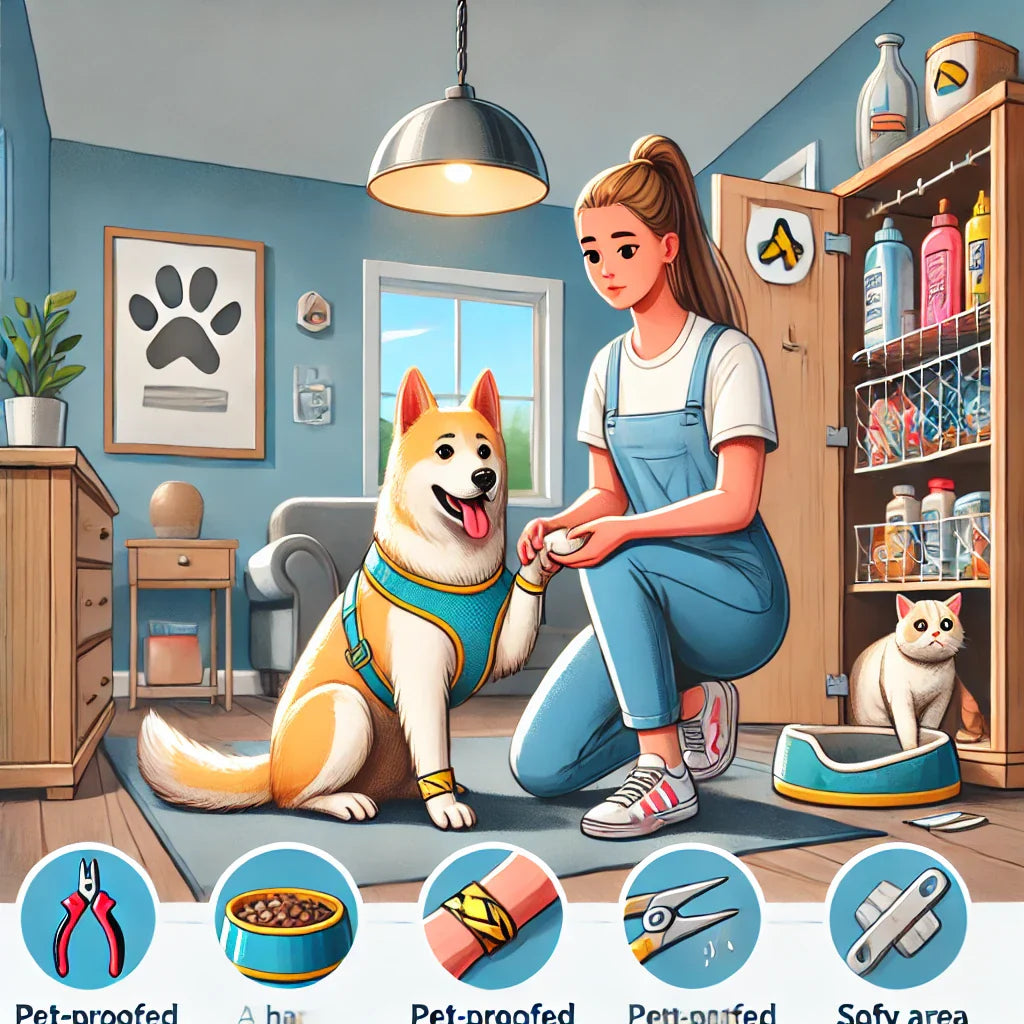
How to Prevent Common Pet Injuries and Save Them from Suffering
Share

Introduction: Why Is Pet Injury Prevention Important?
Every year, thousands of pets suffer from preventable injuries due to accidents, household hazards, or lack of proper training. From choking hazards and poisoning to outdoor accidents and fights, pet owners must take proactive steps to keep their furry companions safe.
This guide will help you:
✅ Pet-proof your home to minimize risks
✅ Prevent pet injuries during walks and playtime
✅ Avoid poisoning, choking, and household hazards
✅ Understand how regular vet check-ups support injury prevention
🐾 Pet-proof your home to minimize the risk of injuries and create a safer space for your pet.
1. Pet-Proofing Your Home: A Step-by-Step Guide
📌 How to Pet-Proof Your Home for Safety
🐕 Common Household Hazards for Pets & Prevention
✔ Electrical cords – Use cord covers or hide them to prevent chewing.
✔ Toxic plants (e.g., lilies, aloe, ivy) – Keep out of reach.
✔ Open windows and balconies – Install pet-proof screens.
✔ Sharp objects & breakables – Store fragile items away from pet-accessible areas.
✔ Human foods toxic to pets – Chocolate, grapes, onions, and xylitol are dangerous.
🐾 Ensure your home is a safe space for your pet—prevent indoor accidents before they happen.
2. Preventing Pet Accidents During Walks & Outdoor Activities
📌 Tips for Preventing Pet Injuries During Walks
✔ Use a secure harness or leash to avoid sudden escapes.
✔ Be aware of hot pavement—check with your hand before walking your pet.
✔ Keep pets away from toxic plants and standing water.
✔ Avoid interactions with aggressive or stray animals.
🐾 Be prepared with first aid techniques to handle injuries in case of outdoor accidents.
3. Preventing Dog Fights & Injuries from Aggression
🐶 Preventing Dog Fights and Injuries
✔ Train your dog with basic commands (sit, stay, leave it).
✔ Socialize early to reduce fear-based aggression.
✔ Never leave dogs unattended with unfamiliar pets.
✔ Watch for warning signs (stiff posture, growling, raised hackles).
📌 What to Do If a Dog Fight Occurs?
✔ Do NOT grab collars—use a loud noise or water spray to separate them.
✔ Cover one dog with a blanket to distract and redirect.
✔ Check for wounds and seek vet care immediately.
🐾 Act fast if your pet chokes by performing the Heimlich maneuver—learn life-saving techniques.
4. Safe Exercise Routines to Prevent Pet Injuries
🚨 Over-exercising or improper play can cause injuries.
📌 Safe Exercise Tips for Dogs & Cats
✔ Warm up before intense play (short walk, light running).
✔ Use proper gear—avoid retractable leashes in busy areas.
✔ Choose safe, pet-approved toys to avoid choking hazards.
✔ Monitor playtime to prevent overexertion.
🐾 Support injury prevention with proper nutrition—healthy pets recover faster from injuries.
5. Avoiding Choking Hazards: Safe Toys & Chews for Pets
📌 Safe Toys and Chews for Pets to Prevent Choking Hazards
✔ Choose size-appropriate toys—avoid small balls or bones that fit entirely in your pet’s mouth.
✔ Avoid cooked bones—they can splinter and cause blockages.
✔ Inspect toys regularly for damage and replace broken ones.
✔ Use slow-feed bowls for pets who eat too quickly.
🐾 Be prepared with first aid techniques to handle injuries—learn to perform pet CPR.
6. Preventing Pet Poisoning at Home
🚨 Common Household Toxins & How to Prevent Accidental Ingestion
📌 Tips for Avoiding Pet Poisoning at Home
✔ Keep medications out of reach—many human drugs are toxic to pets.
✔ Store cleaning supplies in locked cabinets.
✔ Avoid feeding toxic human foods (chocolate, xylitol, grapes, alcohol).
✔ Choose pet-safe pest control methods.
🐾 Be prepared with first aid techniques to handle injuries—know the signs of poisoning.
7. Importance of Regular Veterinary Check-Ups for Injury Prevention
📌 Why Vet Visits Help Prevent Pet Injuries
✔ Early detection of joint or bone issues.
✔ Vaccinations to prevent infections.
✔ Dental care prevents broken teeth and mouth injuries.
✔ Parasite control reduces risks from ticks and fleas.
📌 How Often Should Pets See a Vet?
✔ Puppies/kittens: Every 3-4 months
✔ Adult pets: Once a year
✔ Senior pets: Every 6 months
🐾 Be prepared with first aid techniques to handle injuries—early detection saves lives.
Conclusion: Proactive Steps to Prevent Pet Injuries
Prevention is key when it comes to keeping pets safe. By pet-proofing your home, avoiding choking hazards, and scheduling regular veterinary visits, you can protect your pet from common injuries.
